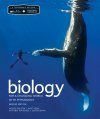About this book
From the groundbreaking partnership of W. H. Freeman and Scientific American comes this one-of-a-kind introduction to the science of biology and its impact on the way we live. Biology for a Changing World explores the core ideas of biology through a series of chapters written and illustrated in the style of a Scientific American article.
New to this edition:
New Chapter Stories
- NASA’s 2012 Curiosity Mission (Ch. 2, Chemistry and Molecules of Life)
- Latest global malnutrition treatments (Ch. 4, Nutrition, Metabolism, Enzymes)
- Discovery and development of cancer blockbuster taxol (Ch. 9, Cell Division and Mitosis)
- Latest stem cell technology, including organ printing (Ch. 13, Stem Cells and Cell Differentiation)
- How urban environments affect animals (Ch. 15, Nonadaptive Evolution and Speciation)
- Greenburg, KS, rebuilding green after destroyed by a tornado (Ch. 24, Ecosystem Ecology)
New Physiology Chapters
- A 30-year heart study in Bogalusa, Louisiana, is the setting for covering the cardiovascular system
- A look at elite athletes training in high altitude is the setting for covering the respiratory system
New Milestones
Each unit features at least one Milestone highlight of an historical important discovery. New to this edition:
- Scientific Rebel about Lynn Margulis and the theory of endosymbiosis
- Progress or Poison? about Rachel Carson and the environmental movement
- Stumbling On a Cure about Frederick Banting, Charles Best, and the discovery of insulin
New! Electronic Instructors Guide
This new teaching tool moves the traditional wraparound annotated teacher’s edition into a convenient interactive environment, enhancing an electronic version of the text with teaching tips, classroom activities, and links in the margins of the screen, just where they will be the most helpful.
New Pedagogy
- New chapter-opening Driving Questions linked with end-of-chapter questions give students a fresh way to focus on the essential ideas of the chapter
- New! More to Explore links lead students to Web sites and articles with additional information about the chapter’s story
- New! Interpreting Data questions ask students to analyze data in tables, charts, or graphs and draw their own conclusions about their meaning
- New! Bring It Home questions ask students to think critically about biological concepts
Contents
1. The Process of Science
2. Chemistry and Molecules of Life
3. Cell Function and Structure
4. Nutrition, Metabolism, Enzymes
5. Energy Flow and Photosynthesis
6. Dietary Energy and Cellular Respiration
7. DNA Structure and Replication
8. Genes to Proteins
9. Cell Division and Mitosis
10. Mutations and Cancer
11. Single-Gene Inheritance and Meiosis
12. Complex Inheritance
13. Stem Cells and Cell Differentiation
14. Natural Selection and Adaptation
15. Nonadaptive Evolution and Speciation
16. Evidence for Evolution
17. Life on Earth
18. Prokaryotic Diversity
19. Eukaryotic Diversity
20. Human Evolution
21. Population Ecology
22. Community Ecology
23. Ecosystem Ecology
24. Sustainability
25. Overview of Physiology
26. Digestive System
27. Cardiovascular System
28. Respiratory System
29. Central Nervous System
30. Reproductive System
31. Immune System
32. Plant Physiology
Customer Reviews
Biography
Michele Shuster, Ph.D. is an assistant professor in the biology department at New Mexico State University in Las Cruces, New Mexico, USA. She focuses on the scholarship of teaching and learning, studying introductory biology, microbiology, and cancer biology classes at the undergraduate level, as well as working on several primary school science education programs.
Janet Vigna, Ph.D. is an associate professor in the biology department at Grand Valley State University in Allendale, Michigan, USA. She is a science education specialist in the Integrated Science Program, training and mentoring primary school science teachers. Her scholarly interests include biology curriculum development, the effective use of digital media in science education, and research on the effects of biological pesticides on the environment.
Matthew Tontonoz has been a development editor for textbooks in introductory biology, cell biology, biochemistry, evolution, and environmental science. He received his B.A. in biology from Wesleyan University, USA and his M.A. in the history and sociology of science from the University of Pennsylvania, USA. His writing has appeared in Science as Culture.

































